Build Custom Software with Ascendix
We help companies automate their workflow by developing bespoke software solutions. Leverage our experience in real estate, legal, financial, and transportation industries.
The lack of alignment in hiring processes may seriously obstruct the company’s growth and scale-up potential. However, a wrong talent management system may cripple the whole organization.
Having realized this, a client of ours has reached out to Ascendix Tech for help with custom recruitment app development.
In this post, I’ll walk you through how to build an applicant tracking system with real-life examples, how different it is from a talent management system, and why HRs abandon their tinned recruitment apps.
An Applicant Tracking System (ATS) is a recruitment app that streamlines the recruitment process by providing a central location for collecting, organizing, and monitoring job applicants. Sometimes called talent acquisition software or candidate management system, it simplifies the hiring process for recruiters by automating many of the time-consuming, repetitive tasks, like:

What Is an Applicant Tracking System | Main Features
A Talent Management System (TMS) is an integrated platform designed to assist with the management of key talent processes within an organization, including but not limited to recruitment, employee onboarding, performance evaluations, training and skill development, management of compensation, and planning for future leadership roles.
They are not. While some of the features of ATS and TMS may overlap, talent management systems are much broader in their application and focus, as apart from recruitment automation, they include functionality for onboarding, learning and development, succession planning, and compensation management.
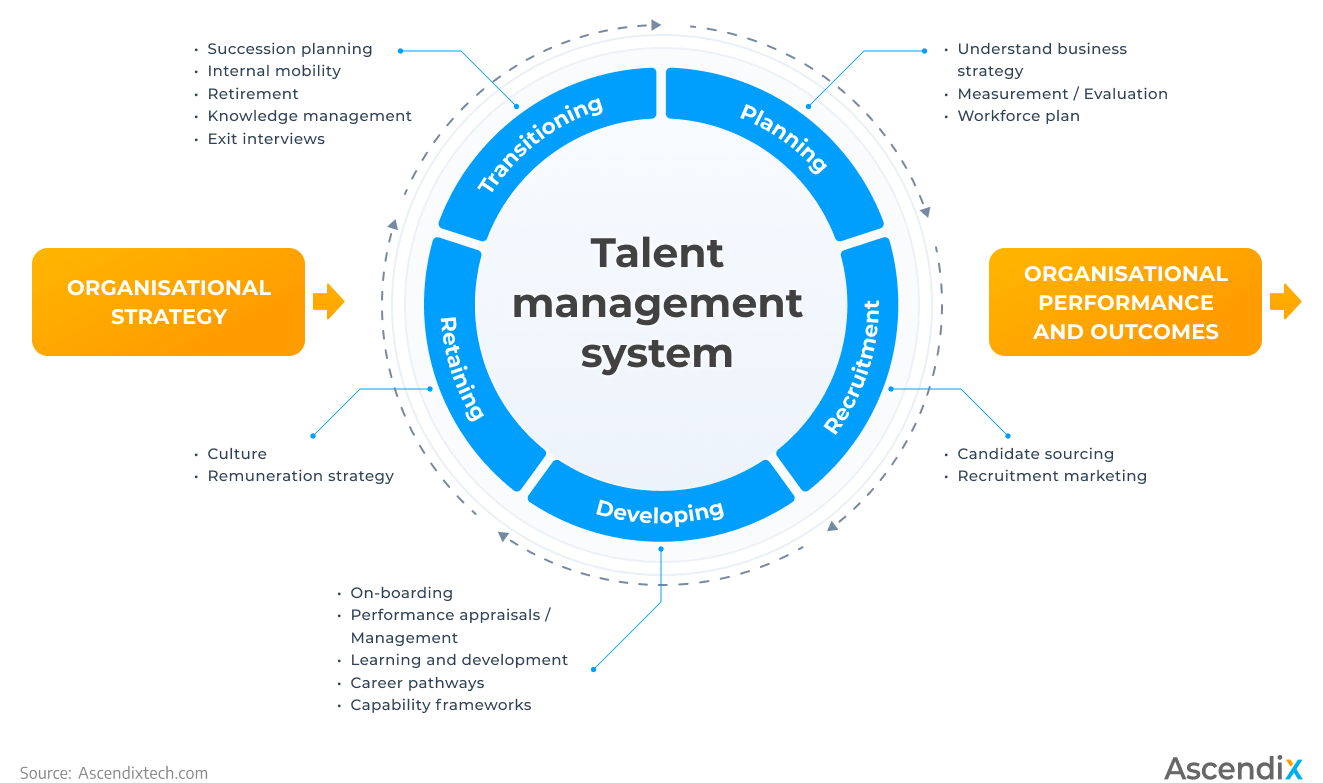
What is a Talent Management System
Development-wise, creating talent management systems involves slightly different development approaches than those to building your own ATS due to an apparently wider scope of functionality and processes covered by the talent management technology. So, make sure to run thorough research to understand what kind of software you need.
However, in this article, I use those terms almost interchangeably, meaning solely recruitment functionality in both.
We help companies automate their workflow by developing bespoke software solutions. Leverage our experience in real estate, legal, financial, and transportation industries.
In 2023, leading talent management technology providers are Workday, AG5 Skills Management, and Personio, according to Capterra (source). Each of these solutions does a great job when it comes to automating or streamlining talent management tasks I mentioned earlier.
However, a common problem with tinned talent management information systems is that they leave close to zero space for customization and scalability. By this I mean that however perfect packaged a recruitment app may look, employers can’t get away without augmenting it to match their niche and organizational needs.
Which is why many companies, just like our client further below, and other recruiters make a tough decision to switch their ATS providers or, even worse, to restore the old way of doing things through Excel sheets.
Other reasons for abandoning tinned talent management software are constant bugs and glitches, poor support service, unintuitive interface, and, obviously, price – any ready-made software will cost you a monthly or yearly subscription.
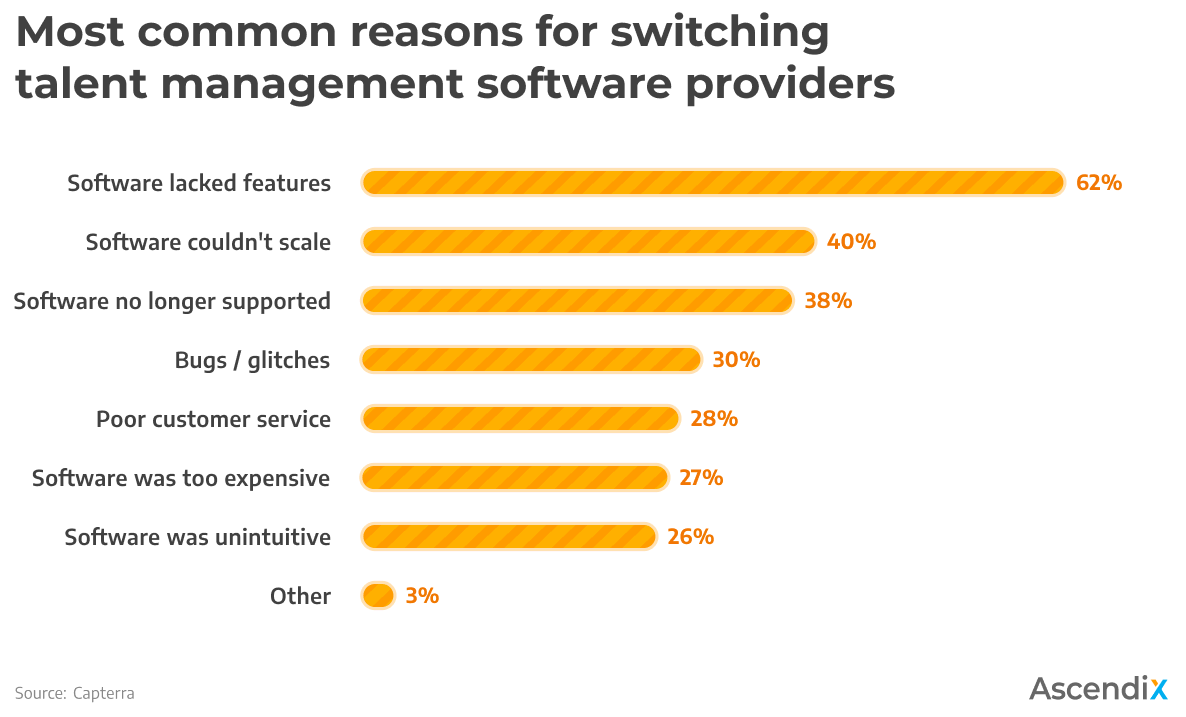
Why Recruiters Give Up on Tinned Recruitment Apps
When creating your own ATS, on the other hand, you tick all these boxes off your list. The main benefits of building your own applicant tracking system include:
Last year, we were involved in the development of a tailored applicant tracking system (ATS) to meet the recruitment needs of our client’s company in the US. The client is a global enterprise with multiple offices and more than 50,000 employees to date – we were engaging with its North American brunch.
The challenge this client of ours was facing was that their previous system, ready-made recruitment app Cornerstone, couldn’t fully integrate the client’s corporate and external recruitment activities – which isn’t surprising at all as most ready-made recruitment apps are designated to be utilized by corporate HR-specialists exclusively.
So, the client turned to Ascendix Tech as a technology expert in workflow automation and creating talent management systems to build their own ATS that would flawlessly reflect their two-faceted hiring process.
In the initial requirements, the client raised several key points:
Hire Ascendix experts. Leverage our experience in real estate, legal, financial, and transportation industries.
Having carefully considered client’s requests, we’ve built a custom recruitment app that allows recruiters/HRs to sign in, register new candidates, invite them for new job positions, check statuses of invitations, assign assessments, and view the results of assessments taken.
Speaking of assessments, the client needed us to integrate the new ATS with their current talent assessment system so all aspects of assessment and learning would be happening there. The new ATS, on the other hand, would be picking up assessment statuses, managing vacancies, and handling communication with talents.
Here’s an outline of this synergy:

How to Create Talent Management System | Architecture and Processes
The UI of our custom-built ATS web application has been developed with an easily maintainable and clean code approach, with all pages built with the help of visual components.
On the left side bar, users can choose between two view modes – “Candidates” and “Job Positions.” Corporate recruiters may access both entities while contractors can only add, edit, delete, assign, and track the progress of Candidates (and not modify Job Positions) if otherwise is not specified by their corporate colleagues (more on the rights division in the role-based security model section).
On the “Job Positions” screen corporate recruiters (but not contractors) can open vacancies by clicking a respective button and filling in the required information, like job title, business line, location, etc.
The important step here is to specify the correct language (should match the preferred language of candidates) and Assessment ID – the unique identification code for the relevant Assessment for this job opening. The assessment itself will be happening in the client’s existing learning environment.
Candidate creation was created a very simple and straightforward process. For this a corporate / external recruiter would just need to input the name of the candidate, their preferred language, and reference ID.
Once a job position and a candidate have been created, corporate recruiters/contractors can assign vacancies to chosen applicants.
There are 2 ways to invite a Candidate for a Job Position:
In the first option, the recruiter/HR has to select a relevant Job Position that would match Candidate’s Preferred Language (if the language of the Job Position doesn’t match that of the Candidate, it simply won’t show up). The search for Job Positions works by the ‘Title’ and ‘Requisition Number’ fields.
In the second option, the recruiter/HR can select an existing Candidate (only Candidates with the same Preferred Language as specified in the current Job Position will show up). In this case, the search for Candidates works by ‘First Name’, ‘Last Name’, ‘Email’, and ‘Reference ID’ fields.
If the Open Date of the Job Position has already come, an invitation email will be sent to the Candidate within 1 hour after its creation. If the Open Date has not come yet, the invitation email will be sent on the Open Date.
Corporate/external recruiters can review invitations sent both from the “Job Positions” and “Candidates” view mode.
After the invitation was sent, recruiters can track the progress of the candidate in the assessment process through invitation statuses.
Statuses of the Invitation represent whether it was just created, sent to the Candidate, whether the Candidate has launched the associated assessment, already completed it, was reminded of it, the invitation expired or the invitation was deleted.
Invitations can be deleted at any of the statuses, and this will unavoidably disable the invitation link previously sent to a Candidate.
Here’s an outline of statuses in our custom-built ATS.
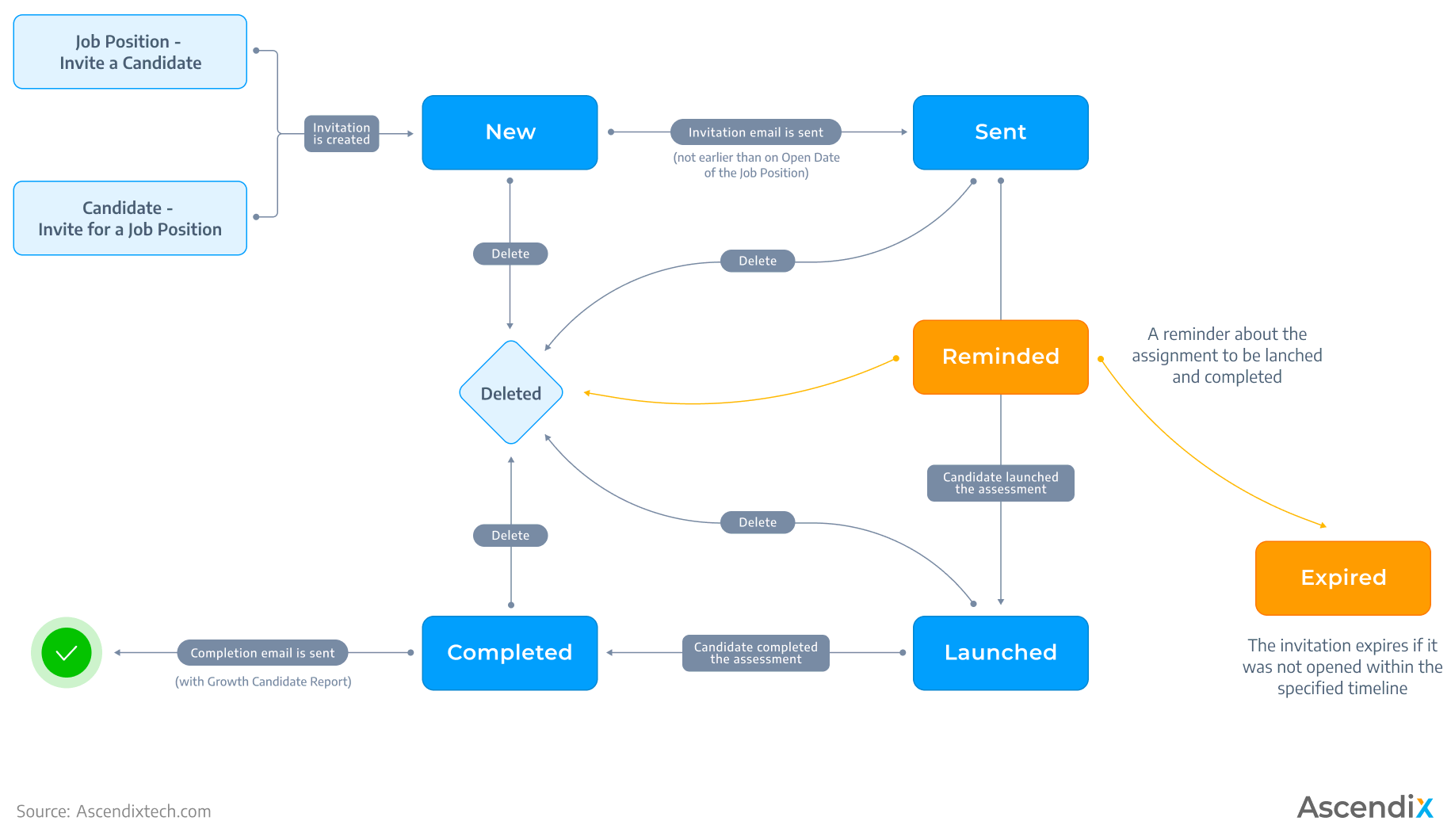
Invitation Statuses in Our Custom ATS
To split the company’s hiring workflow between respective parties – corporate recruiters and contractors – we’ve implemented a role-based security model with 3 user types, each having different permissions and rights:
Here’s an illustration of the main user roles and their relations within our custom-built ATS:
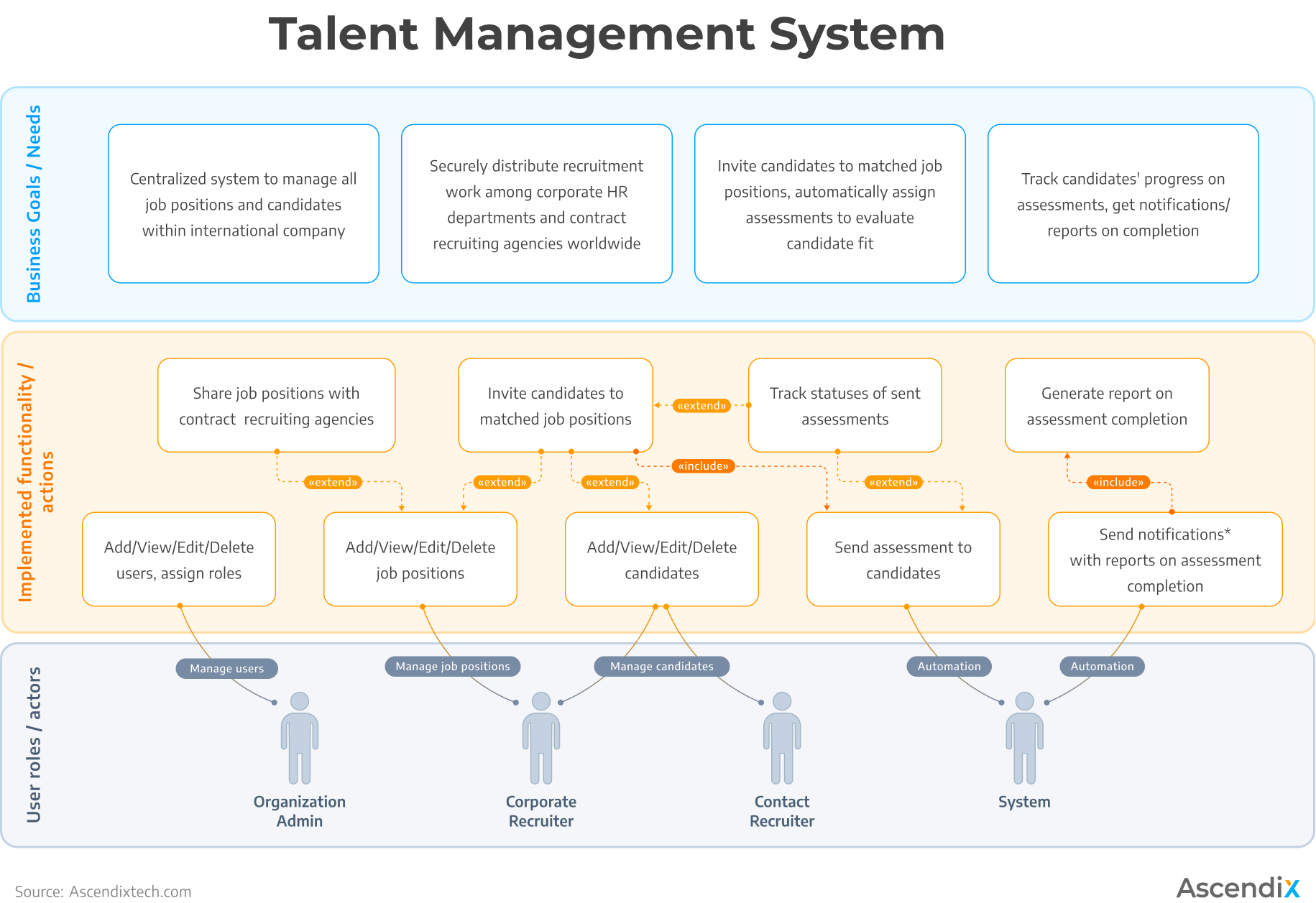
The Main User Roles in Our Custom-Built ATS
The ultimate benefits of implementing role-based security model when building your own ATS include:
Our custom-built ATS application is based using multi-tenant architecture – a software architecture model which means a server runs a single software instance for multiple tenants within a shared environment.
Each tenant has its own data access, permissions, privileges, and adjustments.
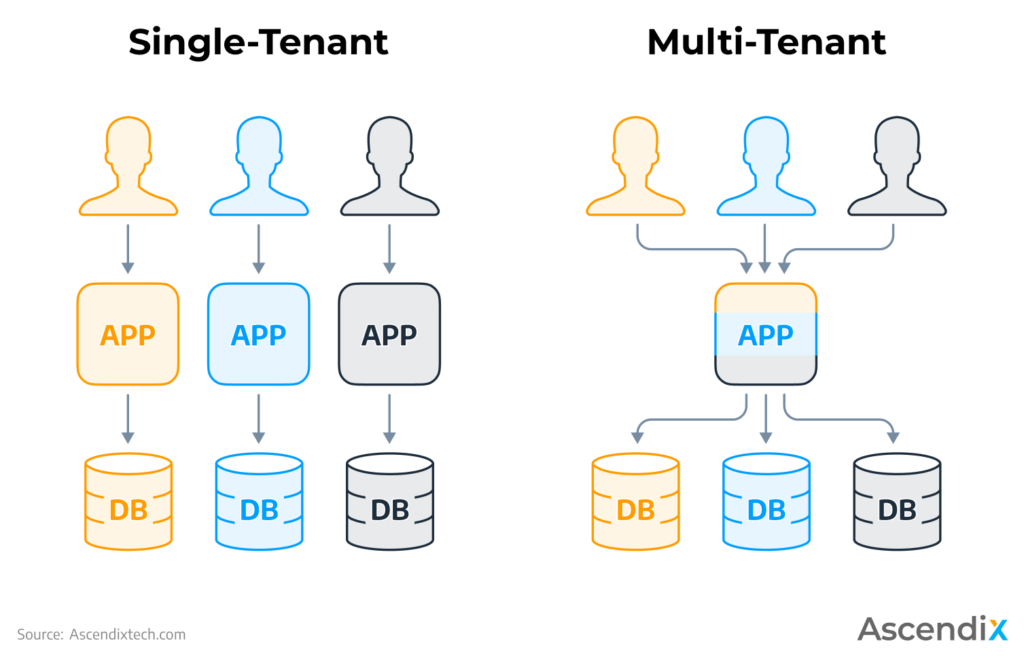
Single Tenant vs Multi Tenant | Talent Management Technology
This architecture model is opposite to single tenancy which means that you need to run a separate infrastructure and software instance for each tenant. Here is why we opted for such architecture model:
Lower costs: By having a single instance of the software serve multiple tenants, the costs of hosting and maintaining the application can be shared among all tenants, resulting in lower costs for each tenant.
Scalability: The ability to easily add new tenants and scale the system as needed can be beneficial for a recruitment app, as the number of users and job postings can fluctuate.
Data isolation: Each tenant’s data is kept separate from other tenants’ data, ensuring that confidential information is not shared with other companies.
Easy upgrades: Upgrades and maintenance can be done on a single instance of the software, reducing downtime and minimizing disruptions for tenants.
However, multi-tenant architecture isn’t flawless, and it does have its shortcomings. So, before implementing it, make sure to consult with your technology partner on overcoming risks associated with multi-tenant architecture and the ways to overcome them.
| Recruitment Software Technology Stack | |||
|---|---|---|---|
| Programming Language | Frameworks & Libraries | Databases | Cloud Platforms |
| JavaScript, C# | .NET, VueJS | PostgreSQL, MongoDB | Azure, AWS |
As a technology advisor, we partner with small firms and global enterprises helping them bring automation to their operational processes.
Ascendix Tech has passed a long 10-year-long way of custom software development and outsourcing to 7 different locations. This bilateral experience allows us to offer a client-vendor balanced expertise tailored to your business needs and niche expectations.
In terms of custom talent management and ATS development, we’ve helped multiple companies build, enhance, and optimize new and existing platforms. For example, we assisted the client in cutting down LMS infrastructure costs by 40 times, resulting in a 256% ROI boost.
How you can benefit from developing your own ATS with Ascendix:
Tell us more about your project, and we’ll make sure to provide you with the knowledge and resources to make innovation happen for you and your business.
To build your own ATS you’ll need at least 1 front end developer, 0,5 business analyst, 1 tester + 0,5 tester for 2 months, 0.25 devops specialist, 2 backend developers, and 0,5 project managers roughly for a year (this will obviously depend on your project complexity). While I can’t be sure about hour rates for such a team as different agencies charge differently, I do know that you can find the best cost-quality ratio by outsourcing your development to Eastern Europe.
This custom ATS development project took us around 6 months. However, please note that we built only applicant tracking system functionality while assessment and reporting was built earlier. When creating a talent management system from scratch, it could take anything from 6 months, like it did for us, to a year. But you could speed up the process using the right project management methodology like Scrum, for example.
The short answer is “no.” While many TMS incorporate ATS functionality, applicant tracking systems are narrower in their application and focus. The two types of software are similar in that they both exist to facilitate the process of recruitment and hiring by automating certain parts of the process.
Alina is a proptech technology expert and a storyteller at Ascendix, investigating the real estate market and sharing her insights and tips with up-and-coming proptech startups, established real estate agencies, and industry stakeholders. She talks about real estate technology, business automation, and industry news.
Get our fresh posts and news about Ascendix Tech right to your inbox.